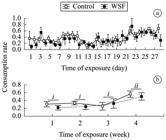Abstract
The influence of the water-soluble fraction of petroleum (WSF) on prey consumption and growth of juvenile trahira Hoplias aff. malabaricus was investigated. Juveniles were submitted to either WSF or Control treatment over 28 days, and jewel tetra Hyphessobrycon eques adults were offered daily as prey for each predator. Total prey consumption ranged from 16 to 86 individuals. Despite the initially lower prey consumption under WSF exposure, there were no significant differences in overall feeding rates between the two treatments. Water-soluble fraction of petroleum had a negative effect on the growth in length of H. aff. malabaricus juveniles. Although unaffected, prey consumption suggested a relative resistance in H. aff. malabaricus to WSF exposition and the lower growth of individuals exposed to WSF than the Control possibly reflects metabolic costs. The implications of the main findings for the individual and the food chain are discussed, including behavioral aspects and the role played by this predator in shallow aquatic systems.
Keywords:
body size; ecotoxicology; growth performance; juvenile trahira; predation; survival

 Thumbnail
Thumbnail
 Thumbnail
Thumbnail

